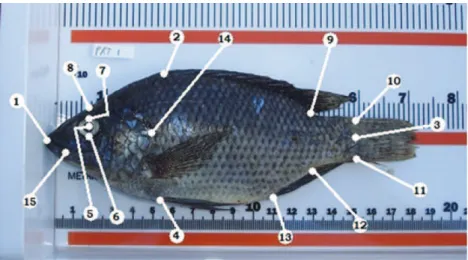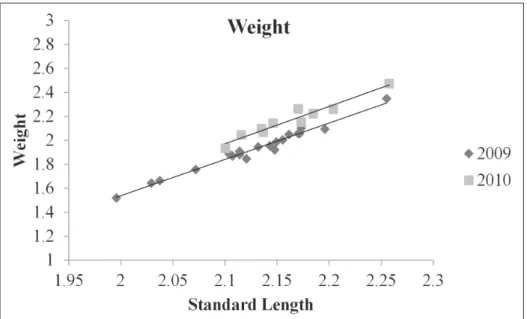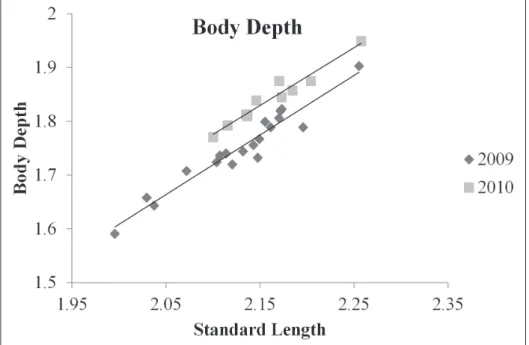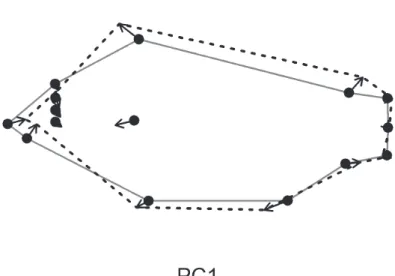Condition and morphometric changes in tilapia
(
Oreochromis
sp.) after an eradication attempt in
Southern Louisiana
O. homas Lorenz1, Patrick Smith2, Lyndon Coghill3
1 Department of Biological Sciences, Georgia Southwestern State University, 800 GSW State University Drive, Americus, GA 31709 2 Pontchartrain Institute of Environmental Sciences, University of New Orleans, 2045 Lakeshore Drive, New Orleans, Louisiana 70122 3 Field Museum of Natural History, 1400 S Lake Shore Drive, Chicago, IL, USA 60605
Corresponding author:O. homas Lorenz (otto.lorenz@gsw.edu)
Academic editor:E. García-Berthou | Received 6 March 2013 | Accepted 5 November 2013 | Published 24 January 2014
Citation: Lorenz OT, Smith P, Coghill L (2014) Condition and morphometric changes in tilapia (Oreochromis sp.) after an eradication attempt in Southern Louisiana. NeoBiota 20: 49–59. doi: 10.3897/neobiota.20.5062
Abstract
A hybrid form of tilapia was introduced into Port Sulphur, Louisiana and was subsequently managed by treatment with rotenone and stocking of native predatory ishes. Measurements of tilapia from before this management event were compared to measurements of tilapia in the two years after the treatment. Post-management tilapia were consistently deeper in body and had greater weight per unit length (condi-tion) when compared to pre-management ish. Procrustes generalized least squares data supported this by consistently inding post-management tilapia to be consistently deeper in body and head shape than pre-management ish. Although this could indicate the efectiveness of stocking native predators, several other factors, including two cold winters, seasonal efects, and less competition, may have contributed to this result.
Keywords
Ivasive, tilapia, morphology, eradication, cichlid
introduction
Previous work has shown that both natural and human impacts can change the mor-phology of populations. Grant and Grant (2002) and Witte et al. (2008) found that changes can occur as a ixed result over years, while Tollrian and Harvell’s (1999) work found it could occur within a generation as phenotypic plasticity. Rapid mor-phological change has been observed as a response to predation in a variety of spe-cies, including plants, cladocerans (Stibor 1992), snails (Brönmark et al. 2011) and ishes (Brönmark and Miner 1992). Fish have shown repeatedly that they can alter their body change in response to predators. Brönmark and Miner (1992) suggested that Crucian Carp (Carassius carassius) could increase their body depth to prevent their consumption by Northern Pike (Esox lucius). Additional studies have shown that Western Mosquitoish, Gambusia ainis, can also change their morphology in response to predators. In contrast to the Crucian Carp, G. ainis have been shown to decrease their body depth, improving their biomechanical capacity for escape (Langer-hans et al. 2004). In addition to predation, other factors can afect ish morphology as well, such as salinity (Collyer et al. 2005), water velocity (Imre et al. 2002) and stunt-ing (Chizinski et al. 2010). A previous study examinstunt-ing tilapia found that invasive Oreochromis mossambicus exhibit a decrease in body depth when compared to their native populations (Firmat et al. 2012).
Tilapia, in particular the genus Oreochromis, have been introduced extensively and are listed as one of the 100 worse invasive species in the world (Lowe et al. 2000). Eradication and understanding of their invasive biology is an important concern to protect biodiversity and local isheries. Although tilapia are a common invasive, no study has examined morphological changes in invasive tilapia after eradication ef-forts. In Port Sulphur, Louisiana there was an introduction of an unknown tilapia species into a seven-mile canal system. Over one million invasive tilapia were killed by rotenone treatment in the summer of 2009 in an eradication attempt monitored by Louisiana Department of Wildlife and Fisheries. No Largemouth Bass (Micropterus salmoides), gar (Lepisosteidae), or other species capable of eating an adult tilapia were collected after the rotenone treatment. One month after rotenone treatments, a variety of predatory ish were then stocked by LDWF and a monitoring program was put in place for the next several years. Ten tilapia were collected during the next two years and then they were not observed for two more years, from April 2011 until at least February of 2013 (Lorenz, unpublished data). he tilapia collected after rotenone treatment and predator stocking were noticeably unique in appearance, apparently with a deeper body.
Methods
Twenty pre-management tilapia were collected by the initial rotenone treatment (2009), and ten post-management tilapia were collected by electroishing (2010). Elec-troishing was performed in the identical location to where ish were sampled before rotenone, within 100 meters of where the canal passes under Highway 23, north of Port Sulphur, Louisiana (29°31'29.87"N, 89°44'49.89"W). Standard length (SL) of each ish was measured to the nearest 0.1 cm on a Wildco ish measuring board, and body mass (BM) was weighed to the nearest 0.1 g on a Ohaus Navigator portable scale. Body depth was also measured to the nearest 0.1cm and all specimens were photo-graphed by a digital camera (Pentax K-10D).
Analysis of Covariance Models
Two diferent analysis of covariance (ANCOVA) tests were performed to compare ish pre and post management. Each measurement (standard length, body depth, and
weight) was log10-transformed prior to analysis for allometric scaling. he predictor
variables for both ANCOVAs were standard length and a factor designating whether each individual ish was pre or post management (hereafter referred to as year). he irst ANCOVA weight as a response variable and the second used body depth as a re-sponse variable. he design of these tests was to see if year was a signiicant predictor
for either response variable with standard length as a covariate (α=0.05). Each model
initially included an interaction between year and standard length. If the interaction
term was not statistically signiicant (at α=0.05), it was removed. he ANCOVAs were
created using R statistical software package version 2.12.1 (R Core Team 2012).
Geometric Morphometrics
Standardized photographs of individuals were entered into TPSDig2 where 15 land-marks were placed on each individual to generate the x and y coordinates used for fur-ther analyses (Rohlf 2005). Landmarks were chosen in a fashion similar to Klingenberg et al. (2003), with additional measurements to indicate other possible morphological changes, such as eye size (Figure 1). Landmark iles were imported into MorphoJ ver-sion 1.04a where partially generalized Procrustes coordinates were generated (Rohlf and Slice 1990, Rohlf and Marcus 1993, Klingenberg 2011).
length (Firmat et al. 2012). For our study, it was not highly correlated with standard
length (R2 = 0.028, p = 0.432), therefore both standard length and centroid size were
used as covariates in our MANCOVA. All interactions were initially included in the
model and any non-signiicant (α=0.05) terms were removed step-wise with higher
order interactions being removed irst.
A between groups PCA (bgPCA) was also performed. We modiied the bgPCA section of the ordination program for R statistical software found in Zeldich et al. (2012) for this part. To remove the efects of centroid size and standard length, residu-als from a multivariate regression were used (Shape ~ centroid size + standard length). he deformation along the irst PC axis was plotted for each coordinate as this has been suggested as a preferred method for interpreting the change in shape data between groups (Mitteroecker and Bookstein 2011).
All analyses after generation of Procrustes coordinates were performed using R statistical software, unless otherwise noted (R Core Team 2012).
Results
Analysis of Covariance Models
An interaction between standard length and year was not found to be a signiicant predictor of weight (ANCOVA, d.f = 1, 26; F = 0.10; P =0.760) or body depth
COVA, d.f. = 1, 26; F = 0.06; P = 0.815), therefore it was excluded from the reduced model for both response variables. he covariate standard length was found to be sig-niicant for both the weight and the body depth ANCOVAs (ANCOVA; d.f. = 1, 27; F = 1041, P < 0.001; ANCOVA; d.f. = 1, 27; F= 539; P < 0.001; respectively). Weight was found to be signiicantly diferent between year groups (ANCOVA; d.f. = 1, 27; F = 109; P < 0.001). Body depth was also found to be signiicantly diferent between year groups (ANCOVA; d.f. = 1, 27; F = 67; P < 0.001). he relationship between both predictor variables and standard length were plotted as a scatter plot. Lines of best it from a linear regression were it to ish from 2009 and 2010. hese plots show that both weight and body depth were higher for ish collected post management (2010) than pre management (2009; Figs 2 and 3).
Geometric Morphometrics
he step-wise model reduction of the MANCOVA indicated there were no signiicant interactions included in our model (all P values > 0.05). Using both centroid size and standard length as covariates, year bins were signiicantly diferent with respect to Procrustes coordinates (d.f = 5, 22; F = 8.9; P < 0.001; Table 1). hese data suggests that variation between years is still apparent and it aligns along the irst PC axis which
Figure 2. Relationship between log transformed standard length and log transformed weight as a scat-ter plot for ish from pre and post management (2009 and 2010, respectively). Two lines of best it were created, one for each year group. he regression function for 2009 was y = -3.03x – 4.53, and was y = -3.12x – 4.57 for 2010, where y is log10 transformed weight in grams and x is log10 transformed standard
explains 35% of the total variation in shape among measured ish. Figure 4 shows rep-resentative ish from 2009 and 2010.
Figure 5 shows the deformation along PC1 of the bgPCA and illustrates marked diferences between year categories. Procrustes coordinates near the anterior end of the
table 1. Table showing the results of the MANCOVA performed on shape for year bins.
Efect df Pillai F P
Standard length 5, 22 0.73 11.9 < 0.001 Centroid size 5, 22 0.74 12.8 < 0.001
Year 5, 22 0.67 8.9 < 0.001
Figure 3. Relationship between log transformed standard length (x-axis) and log transformed body depth (y-axis) as a scatter plot for ish from pre and post management (2009 and 2010, respectively). Two lines of best it were created, one for each year group. he regression function for 2009 was y = 1.11x – 0.61, and was y = 1.08x – 0.48 for 2010, where y is log10 transformed body depth in mm and x is log10 transformed standard length in mm.
ish are drawn in a posterior direction, while Procrustes coordinates at the anterior end of the dorsal and anal ins shift outward dorsoventrally and toward the anterior of the ish (Figure 5). his suggests the ish are becoming taller in body depth and shorter in overall length between year classes.
Discussion
Results from both ANCOVAs and all geometric morphometric analyses suggest that tilapia from each year bin were morphologically distinct. Post-management ish had higher bodies and were heavier per unit length than pre-management ish. he nature of our study, as well as other natural experiments, makes determining casual agents dif-icult if not impossible. However, the results presented here indicate that some under-lying process(es) between the rotenone treatment in 2009 and 2010 caused signiicant changes in the morphology of tilapia from our study area.
Many possible reasons could explain this change in morphology. his apparent change in morphology could be an indicator of the success of the management plan stocking native predators. Past studies have shown that stocked predators can cause a change in the morphology of their prey (Brönmark and Miner 1992). Body depth increased in these tilapia in the same way that carp have shown increases in their body
depth in response to predacious northern pike. It is important to consider other envi-ronmental conditions that occurred during this time, as well as other factors that are known to afect ish morphology besides predation.
After rotenone treatment there was a dramatic decrease in ish density and a clear decrease in tilapia abundance. While this is the desired efect of this method of manage-ment, it also reduces the level of competition in this habitat. Multiple tilapia could easily be caught with a blind throw of a cast net before the rotenone treatment (Lorenz pers. obs.). his sort of density can create stunting in ish, and stunting often has the opposite morphological efect of predators (Chivers et al. 2008). he higher bodied tilapia after the rotenone treatment may have acquired this morphology because of a release from such competition. Other studies on the efects of resource limitation have not been as conclusive, with diferent morphological changes observed in diferent species (Chizinski et al. 2010). he winters of 2009 and 2010 created water temperatures below 10 degrees Celsius in these canals, which is below the normally accepted lower thermal limit for this species (Green et al. 2012). he efect of temperature on morphology of ishes has been mostly unexplored, however one study did observe European sea bass (Dicentrarchus labrax) to be more slender at lower temperatures (Georgakopoulou et al. 2007). While this pattern would be opposite of our observations in this study, we felt it is important to acknowledge that temperature has been shown to afect ish morphology.
Breeding condition may also be a factor, as tilapia have been shown to have a change in body condition (and presumably morphology) depending on season (Hirpo 2012). Body condition changes were observed in Nile tilapia (Oreochromis niloticus), between the breeding and non-breeding seasons (Hirpo 2012). It is worth noting that the 2009 tilapia from this study were caught during the breeding season and the 2010 tilapia were caught out of the breeding season. It has also been shown that invasive spe-cies such as bluegill (Lepomis macrochirus) can produce diferent morphologies to feed on more pelagic or benthic prey (Yonekura et al. 2007). Such a large scale change in the Port Sulphur canal ecosystem driven by the rotenone treatment could have changed what food was available to the tilapia. But all stomach contents examined for both years appeared to contain only algae and detritus (Lorenz, unpublished data), leading us to believe this efect was minimal.
Conclusion
Invasive species are a serious threat, in part because they can be phenotypically plastic (Davidson et al. 2011) and can induce morphological changes in native species (Phillips and Shine 2006). Examining these changes can indicate the adaptability and impact of invasive species. If these changes can also indicate the success or unintended impact of management practices, there is a tremendous potential beneit. Tilapia from Port Sulphur changed signiicantly in morphology between pre and post-management year groups, and this change may have occurred because of the predators intentionally introduced to control their population. Further experiments could eliminate other reasons for such a change in morphology and determine if the predators were the most likely cause for the morphological changes observed. Using predatory game ish for management of invasive species can be successful, as seen with the reduction of invasive alewife (Alosa pseudo-harengus) by introduced Paciic salmon (Oncorhynchus spp.) in Lake Michigan (Fenichel et al. 2010). In addition to control of non-native species, there are additional beneits gained from these methods including the preservation of biodiversity and native isheries.
Acknowledgements
his study was possible because of a grant from the Louisiana Department of Wild-life and Fisheries acquired by the irst author and M O’Connell, University of New Orleans. LDWF employees M. Kaintz and T. Ruth aided in providing specimens for examination. his manuscript represents publication No. 12 for the Nekton Research Laboratory, Pontchartrain Institute for Environmental Sciences.
References
Brönmark C, Miner JG (1992) Predator-induced phenotypical change in body morphology in crucian carp. Science 258: 1348–1350. doi: 10.1126/science.258.5086.1348
Brönmark C, Lakowitz T, Hollander J (2011) Predator-Induced Morphological Plasticity Across Local Populations of a Freshwater Snail. PLoS ONE 6(7): e21773. doi: 10.1371/ journal.pone.0021773
Chivers D, Zhao X, Brown G, Marchant T, Ferrari M (2008) Predator-induced changes in morphology of a prey ish: the efects of food level and temporal frequency of predation risk. Evolutionary Ecology22: 561–574. doi: 10.1007/s10682-007-9182-8
Chizinski CJ, Pope KL, Wilde GR, Strauss RE (2010) Implications of stunting on morphol-ogy of freshwater ishes. Journal of Fish Biolmorphol-ogy 76: 564–579. doi: 10.1111/j.1095-8649.2009.02498.x
Fenichel EP, Horan RD, Bence JR (2010) Indirect Management of Invasive Species hrough Bio-Controls: A Bioeconomic Model of Salmon and Alewife in Lake Michigan. Resource and Energy Economics 32: 500–518. doi: 10.1016/j.reseneeco.2010.04.002
Firmat C, Schliewen UK, Losseau M, Alibert P (2012) Body shape diferentiation at global and local geographic scales in the invasive cichlid Oreochromis mossambicus. Biological Journal of the Linnean Society 105: 369–381. doi: 10.1111/j.1095-8312.2011.01802.x
Georgakopoulou E, Sfakianakis DG, Kouttouki S, Divanach P, Kentouri M, Koumoundouros G (2007) he inluence of temperature during early life on phenotypic expression at later ontogenetic stages in sea bass. Journal of Fish Biology 70: 278–291. doi: 10.1111/j.1095-8649.2007.01305.x
Grant PR, Grant BR (2002) Unpredictable evolution in a 30-year study of Darwin’s inches. Science 296: 707–711. doi: 10.1126/science.1070315
Green CC, Kelso WE, Kaller MD, Gautreaux KM, Kelly DG (2012) Potential for Naturaliza-tion of Nonidigenous Tilapia Oreochromis sp. in Coastal Louisiana Marshes Based on Inte-grating hermal Tolerance and Field Data. Wetlands32: 717–723. doi: 10.1007/s13157-012-0304-x
Hirpo LA (2012) Breeding Season and Condition Factor of Oreochromis niloticus in Leke Babo-gaya, Ethiopia. International Journal of Agricultural Sciences 2(3): 116–120
Imre I, Mclaughlin RL, Noakes DL (2002) Phenotypic plasticity in brook char (Salvelinus fontinalis): changes in caudal in induced by water low. Journal of Fish Biology 61: 1171– 1181. doi: 10.1111/j.1095-8649.2002.tb02463.x
Klingenberg C, Barluenga M, Meyer A (2003) Body shape variation in cichlid ishes of the
Amphilophus citrinellus species complex. Biological Journal of the Linnean Society 80: 397–408. doi: 10.1046/j.1095-8312.2003.00246.x
Klingenberg CP (2011) MorphoJ: an integrated software package for geometric morphomet-rics. Molecular Ecology Resources 11: 353–357. doi: 10.1111/j.1755-0998.2010.02924.x Langerhans RB, Layman CA, Shokrollahi AM, DeWitt TJ (2004) Predator-driven phenotypic
diversiication in Gambusia ainis. Evolution 58: 2305–2318.
Mitteroecker P, Bookstein F (2011) Linear Discrimination, Ordination, and the Visualization of Selection Gradients in Moddern Morphometrics. Evolutionary Biology 38: 110–114. doi: 10.1007/s11692-011-9109-8
R Core Team (2012) R: A language and environment for statistical computing. R Foundation for Statistical Computing, Vienna, Austria. ISBN 3–900051–07–0 http://www.R-project. org/
Rohlf FJ, Slice D (1990) Extensions of the Procrustes method for the optimal superimposition of landmarks. Systematic Zoology 39: 40–59. doi: 10.2307/2992207
Rohlf FJ, Marcus LF (1993) A revolution in morphometrics. Trends in Ecology and Evolution 8: 129–132. doi: 10.1016/0169-5347(93)90024-J
Rohlf FJ (2005) tpsDig, digitize landmarks and outline, version 2.05. Department of Ecology and Evolution, State University of New York at Stony Brook.
Stibor H (1992) Predator induced life-history shifts in a freshwater cladoceran. Oecologia 92: 162–165. doi: 10.1007/BF00317358
Tollrian R, Harvell CD (1999) he ecology and evolution of inducible defenses. Princeton University Press (Princeton): 1–395.
Winemiller KO, Taylor DH (1982) Inbreeding depression in the convict cichlid, Cichlasoma nigrofasciatum (Baird and Girard). Journal of Fish Biology 21: 399–402. doi: 10.1111/ j.1095-8649.1982.tb02844.x
Witte F, Welten M, Heemskerk M, van der Stap I, Ham L, Rutjes H, Wanink J (2008) Major morphological changes in a Lake Victoria cichlid ish within two decades. Biological Jour-nal of the Linnean Society 94: 41–52. doi: 10.1111/j.1095-8312.2008.00971.x
Yonekura R, Kohmatsu Y, Yuma M (2007) Diference in the predation impact enhanced by morphological divergence between introduced ish populations. Biological Journal of the Linnean Society 91: 601–610. doi: 10.1111/j.1095-8312.2007.00821.x



